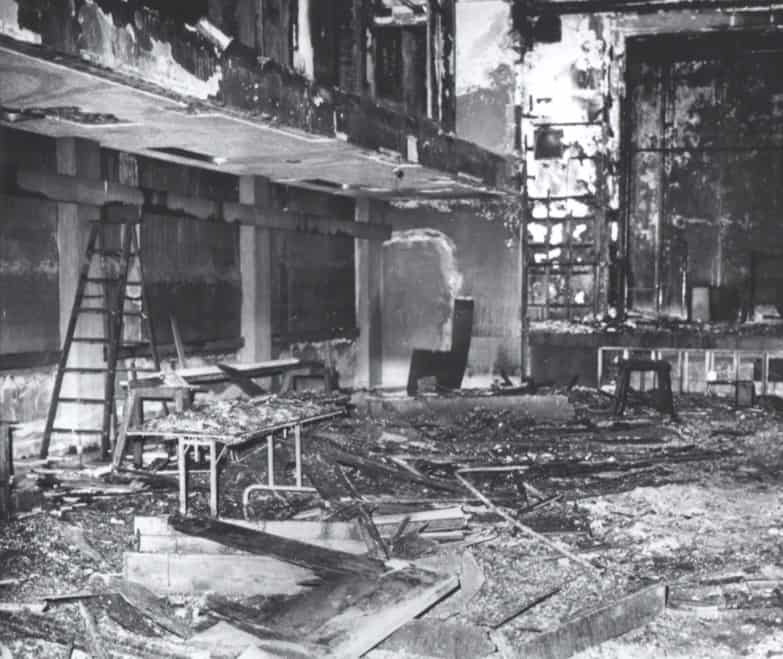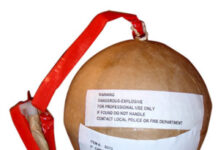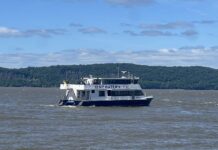
By Mary Hoar, President Emerita, Yonkers Historical Society, recipient of the 2004 Key to History, President Untermyer Performing Arts Council
Monday, December 14th
December 14, 1888: The Statesman kicked off its anti-saloon campaign by publishing the Anti-Saloon Republican National Committee’s platform. Liquor traffic was condemned as a commerce of iniquity that not only served no good purpose, it destroyed the drinker and degraded the distiller and the dealer. The platform further stated every saloon established would turn into a “preparatory school for the asylum and the almshouse, the jail and the gibbet.”
December 14, 1888: The efforts of the new management of the Yonkers Street Railroad Company to improve service led them to institute “two horse service” on the Warburton Avenue line as well as repairing the tracks. Management said two horses pulling the cars insured better time as well as the cars running on time.
December 14, 1931: Yonkers Avenue resident Mario Costasino was cleared of responsibility for hitting Winston Churchill with his car… by Churchill! His car knocked down the British Statesman as he tried to cross Fifth Avenue in NYC; Churchill admitted he tried to cross the street against the lights… and in the middle of the block. Police did not hold Constasino after Churchill told them the accident was unavoidable.
Tuesday, December 15th
December 15, 1934: After hearing from the Yonkers Railroad Company they had won the right to charger higher fares, the Public Service Commission went into special session to study this amazing claim.
December 15, 1937: Lawrence Street’s Clara Shindlman prevented an attempted robbery at the Hope Newman Company’s clothing store on North Broadway. She grappled with the armed bandit, relieving him of his coat before he ran from the store!
December 15, 1947: Ted Worner, manager of the 1946 Yonkers Tercentennial office, received letters from our special guests from Yonkers, Oklahoma. They shared that, because of the construction of the Fort Gibson dam, the townspeople “might have to move from Yonkers before long,” making us the only Yonkers in the US. In fact, several of the eleven Oklahoma people who visited our fair city already had moved, including the village’s postmistress. Life of the little town, founded by George Lowerre of Yonkers, officially ended when officials filled Fort Gibson Lake and flooded the town a few years later.
Wednesday December 16th:
December 16, 1917: Yonkers began two “lightless nights” a week to save fuel. Yonkers “white ways,” and all electric signs were to be darkened. Only necessary streetlights were used.
December 16, 1925: Federal agents dumped hundreds of gallons of beer into the Nepperhan River at the request of the Bittersweet Products Corporation of Chicken Island. The company had a permit to “dealcoholize” the liquor, but felt the final product was unusable.
December 16, 1932: Federal agents, wanting to “dry up Yonkers” before the Christmas holidays, raided six taverns and arrested six bartenders; they also planned to use padlocks to keep the establishments closed.
Thursday, December 17th:
December 17, 1912: Irwin Cobb, nationally known author and humorist, gave a party for daughter Elizabeth at the family home on Edgecliff Terrace; more than 35 guests attended.
December 17, 1942: Billy Lohrfink, while on night guard duty in New Jersey, heard someone coming. He called out, “Halt! Who goes there?” The answer came quickly, “Officer of the Day.” Billy responded, “Advance to be recognized!” Lohrfink quickly presented arms and was returned with a salute. There was no problem recognizing the officer of the day because it was Second Lieutenant Clark Gable!
December 17, 1943: The Yonkers Academy of Medicine adopted a resolution supporting the policy of Health Commissioner Eugene McGillian putting a “gag rule” on the names and locations of children and adults who were diagnosed with polio, typhoid and meningitis in our city; surprisingly State Health Commissioner, Dr. Edward Godfrey, supported the decision. This contradicted the policy of transparency set by the late local Health Commissioner Dr. Buckmaster, one that let the public know where the locations of people with contagious diseases were.
Friday, December 18th:
December 18, 1915: The Common Council voted to continue placing ornamental lights in front of homes of former Mayors of Yonkers.
December 18, 1917: The Yonkers Bureau of Municipal Research announced if Yonkers continued to grow at its current rate, it would double its population by 1935. Our city possibly could be on the verge of merging with New York City… or feasibly already be a part of NYC!
December 18, 1937: Yonkers taxpayers examining the proposed 1938 budget were upset to learn 158 jobs had been added to the city payroll since the 1937 budget had been adopted, increasing the cost of our government by $134,800.
Saturday, December 19th:
December 19, 1911: Supreme Court Justice Keogh today signed an order directing James Ball, Jr., of Yonkers be reinstated as foreman in the Department of Public Works at his former salary of $31.50 per week, and be paid retroactively from the date he was “removed from his position illegally.”
December 19, 1931: On recommendation of School Trustee Dr. John Faiella, the Board of Education approved tuberculin testing as a way to help combat the spread of TB.
December 19, 1937: More than 400 property owners loudly protested Yonkers real estate taxation, and demanded relief at the Common Council meeting. The meeting finally was adjourned at 1 a.m.
Sunday, December 20th
December 20, 1927: Mayor William Walsh, in the last few days in office, recommended the Common Council carry on improvements he began making for our city. He suggested: replacing wooden lighting poles with ornamental poles; completing enclosure of the Nepperhan River and building a highway on top of it; building a stadium in Glen Park; and making a comprehensive study of the Yonkers waterfront.
December 20, 1937: Six unnamed witnesses were called before the Westchester Grand Jury to testify about allegations of fraud in the Yonkers general election.
December 20, 1965: Nine children and three adults were killed in a fire that swept through the Jewish Community Center; this is considered by many to be the most tragic fire in Yonkers history.
For more information on the Yonkers Historical Society, Sherwood House and our upcoming events, please visit our website www.yonkershistoricalsociety.org, call 914-961-8940 or email yhsociety@aol.com.





